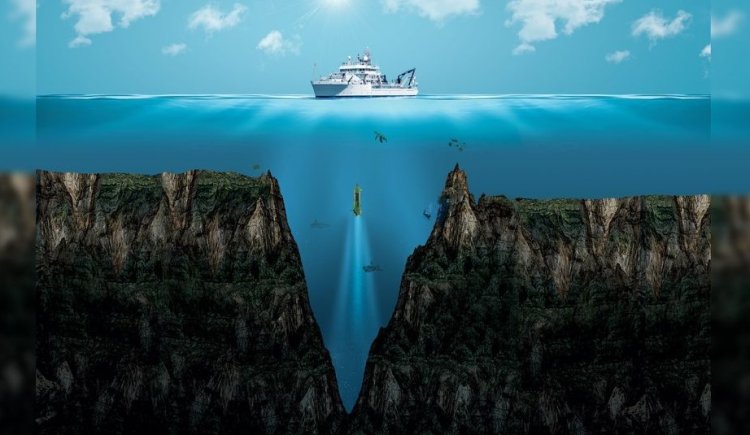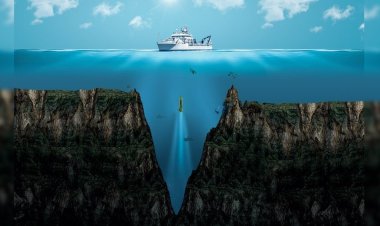The Mariana Trench: Earth's Deepest Mystery

The Mariana Trench, located in the western Pacific Ocean, is a geological marvel and the deepest part of the world's oceans, plunging to depths of about 36,000 feet (over 10,900 meters). Despite its profound depths, the trench remains one of the least explored and understood areas on our planet. This mysterious abyss harbors secrets about Earth's history, marine biology, and even the potential for extraterrestrial life.
Geological Significance
The trench was formed by the process of subduction, where the Pacific Plate is being forced beneath the Mariana Plate. This tectonic activity not only creates the trench but also leads to significant geological phenomena such as earthquakes and volcanic eruptions in the region. Understanding the trench’s geological processes can provide insights into the Earth's formation and the dynamics of tectonic plates, making it crucial for scientists studying plate tectonics and geological hazards.
Biodiversity and Extremophiles
One of the most fascinating aspects of the Mariana Trench is its unique ecosystem. Despite the extreme conditions—high pressure, low temperatures, and complete darkness—scientists have discovered a variety of life forms. Organisms such as the amphipod shrimp, certain species of bacteria, and even deep-sea fish have adapted to these harsh environments, showcasing the resilience of life.
These creatures, often referred to as extremophiles, have evolved unique biological mechanisms to survive. For instance, some organisms possess specialized proteins that function optimally under high pressure, while others produce chemicals to withstand the cold and darkness. Studying these extremophiles could unlock new scientific advancements, including medical breakthroughs and biotechnological applications.
Exploration Challenges
Exploring the Mariana Trench is fraught with challenges. The immense pressure at the bottom of the trench is over 1,000 times greater than at sea level, making it difficult for submersibles and remotely operated vehicles (ROVs) to function. Past explorations, such as James Cameron’s historic solo dive in 2012 and the five dives of the DSV Limiting Factor by explorer Victor Vescovo, have provided invaluable data, but only a fraction of the trench has been mapped or studied in detail.
High costs, technical limitations, and the vastness of the ocean all contribute to the challenges of deep-sea exploration. However, advancements in technology are paving the way for future missions. The development of more resilient submersibles and advanced imaging techniques could enable deeper and more comprehensive exploration of the trench.
Environmental Concerns
As humanity's activities continue to impact the oceans, the Mariana Trench faces threats from pollution, deep-sea mining, and climate change. Microplastics have been found in the deepest parts of the ocean, including the trench, raising concerns about the effects of human pollution on these remote ecosystems. Additionally, the potential for deep-sea mining poses risks to the fragile habitats that have evolved over millions of years.
Conservationists advocate for the protection of these unexplored depths, arguing that preserving the trench is vital not just for marine biodiversity but also for understanding global environmental changes. Efforts are underway to establish marine protected areas that can help safeguard the trench and its unique ecosystems from exploitation.
Cultural Impact and Scientific Inspiration
The Mariana Trench has captured the imagination of many, inspiring literature, films, and documentaries. Its enigmatic nature has made it a symbol of the unknown, representing the mysteries that still exist in our world. Scientific expeditions to the trench not only contribute to our understanding of marine biology and geology but also inspire future generations of scientists and explorers.
Moreover, the trench serves as a reminder of the importance of ocean conservation. As we learn more about the depths of our oceans, we are prompted to consider our relationship with the environment and the impact of our actions on these vital ecosystems.
The Future of Exploration
Looking ahead, the exploration of the Mariana Trench is set to continue, with upcoming missions planned to delve deeper and uncover more about this abyss. Scientists are eager to explore uncharted territories, collect samples, and study the effects of climate change on deep-sea ecosystems.
International collaboration will be essential in these efforts, as ocean exploration knows no borders. By working together, countries can share data, resources, and expertise, enhancing our collective understanding of the trench and promoting sustainable practices to protect its fragile environment.
Conclusion
The Mariana Trench remains one of Earth's greatest mysteries, a place where life thrives in unimaginable conditions and geological processes reveal the planet's history. As we continue to uncover its secrets, we are reminded of the importance of preserving these unique ecosystems and the wonders of our natural world. The trench not only challenges our understanding of life and the planet but also inspires us to protect and explore the oceans that cover over 70% of Earth’s surface. In our quest for knowledge, the Mariana Trench stands as a testament to the uncharted realms of science and the enduring allure of the unknown.


